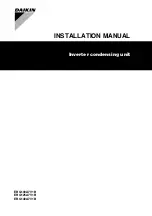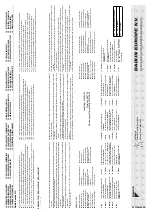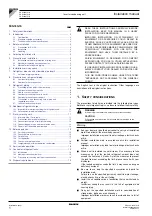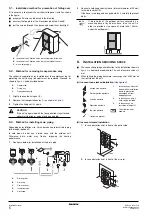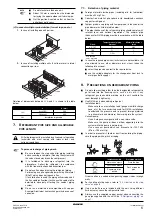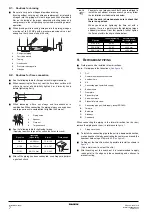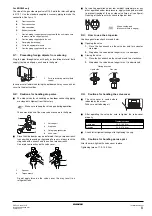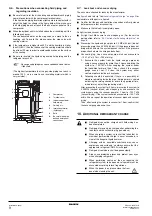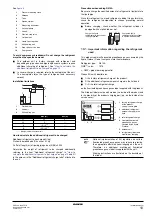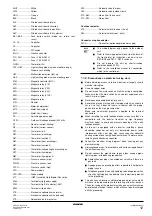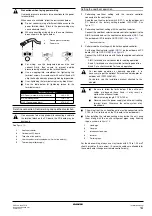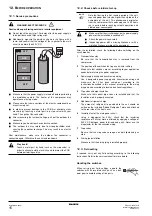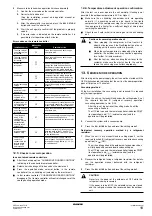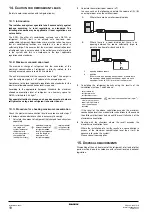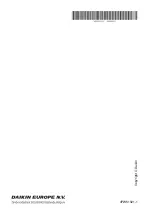
ERQ100~140A7V1B
Inverter condensing unit
4PW51321-1
Installation manual
12
WHT ...................... White
YLW ....................... Yellow
ORG ...................... Orange
BLK........................ Black
A1P........................ Printed circuit board (main)
A2P........................ Printed circuit board (inverter)
A3P........................ Printed circuit board (noise filter)
A4P........................ Printed circuit board (C/H selector)
BS1~BS5 ............... Push button switch (mode, set, return, test,
reset)
C1~C3 ................... Capacitor
C4 .......................... Capacitor
DS1........................ DIP switch
E1HC ..................... Crankcase heater
F1U, F4U ............... Fuse (T 6.3 A/250 V)
F6U........................ Fuse (T 5.0 A/250 V)
FINTH .................... Thermistor (fin)
H1P~H8P .............. Light emitting diode (service monitor orange)
Prepare, test: blinking
H2P........................ Malfunction detection: light up
HAP ....................... Light emitting diode (service monitor green)
K1M ....................... Magnetic contactor (M1C)
K1R........................ Magnetic relay (Y1S)
K2R........................ Magnetic relay (Y2S)
K3R........................ Magnetic relay (Y3S)
K4R........................ Magnetic relay (E1HC)
K5R........................ Magnetic relay
L1R ........................ Reactor
M1C ....................... Motor (compressor)
M1F ....................... Motor (fan) (upper)
M2F ....................... Motor (fan) (lower)
PS.......................... Switching power supply
Q1DI ...................... Field earth leakage breaker (300 mA)
R1 .......................... Resistor (current limiting)
R2 .......................... Resistor (current sensor)
R1T........................ Thermistor (air)
R2T........................ Thermistor (discharge)
R3T........................ Thermistor (suction 1)
R4T........................ Thermistor (heat exchanger)
R5T........................ Thermistor (suction 2)
R6T........................ Thermistor (subcooling heat exchanger)
R7T........................ Thermistor (liquid pipe)
R8T........................ Thermistor (liquid pipe 2)
S1NPH................... Pressure sensor (high)
S1NPL ................... Pressure sensor (low)
S1PH ..................... Pressure switch (high)
V1R........................ Power module
V2R, V3R............... Diode module
V1T ........................ IGBT (Insulated Gate Bipolar Transistor)
X1M ....................... Terminal strip (power supply)
X1M ....................... Terminal strip (C/H selector) (A4P)
X2M ....................... Terminal strip (control)
Y1E........................ Electronic expansion valve (main)
Y3E........................ Electronic expansion valve (subcool)
Y1S........................ Solenoid valve (4 way valve)
Y2S ........................ Solenoid valve (hot gas)
Y3S ........................ Solenoid valve (unload circuit)
Z1C~Z8C ............... Noise filter (ferrite core)
Z1F~Z4F ................ Noise filter
Cool/heat selector
S1S ........................ Selector switch (fan/cool – heat)
S2S ........................ Selector switch (cool – heat)
Connector of option adaptor
X37A ...................... Connector (option adaptor power supply)
11.2. Precautions on electrical wiring work
■
Before obtaining access to terminal devices, all supply circuits
must be interrupted.
■
Use only copper wires.
■
Do not turn on the main switch until all the wiring is completed.
Make sure that the main switch has a contact separation of at
least 3 mm in all poles.
■
Never squeeze bundled cables into a unit.
■
Secure the electrical wiring with clamping material as shown in
so that it does not come in contact with the piping,
particularly on the high-pressure side.
Make sure no external pressure is applied to the terminal
connectors.
■
When installing the earth leakage breaker make sure that it is
compatible with the inverter (resistant to high frequency
electrical noise) to avoid unnecessary opening of the earth
leakage breaker.
■
As this unit is equipped with an inverter, installing a phase
advancing capacitor not only will deteriorate power factor
improvement effect, but also may cause capacitor abnormal
heating accident due to high-frequency waves. Therefore, never
install a phase advancing capacitor.
■
Follow the "electrical wiring diagram" when carrying out any
electrical wiring.
■
Always ground wires. (In accordance with national regulations of
the pertinent country.)
■
Do not connect the ground wire to gas pipes, sewage pipes,
lightning rods, or telephone ground wires.
■
Combustion gas pipes: can explode or catch fire if there is a
gas leak.
■
Sewage pipes: no grounding effect is possible if hard plastic
piping is used.
■
Telephone ground wires and lightning rods: dangerous when
struck by lightning due to abnormal rise in electrical potential
in the grounding.
■
This unit uses an inverter, and therefore generates noise, which
will have to be reduced to avoid interfering with other devices.
The outer casing of the product may take on an electrical charge
due to leaked electrical current, which will have to be discharged
with the grounding.
NOTE
■
This wiring diagram only applies to the outdoor
unit.
■
Refer to the wiring diagram sticker (on the back of
the front plate) for instructions on how to use
BS1~BS5 and DS1-1, DS1-2 switches.
■
Do not operate the unit by short-circuiting
protection device S1PH.
■
Refer to the installation manual for connection
wiring to the control box.

